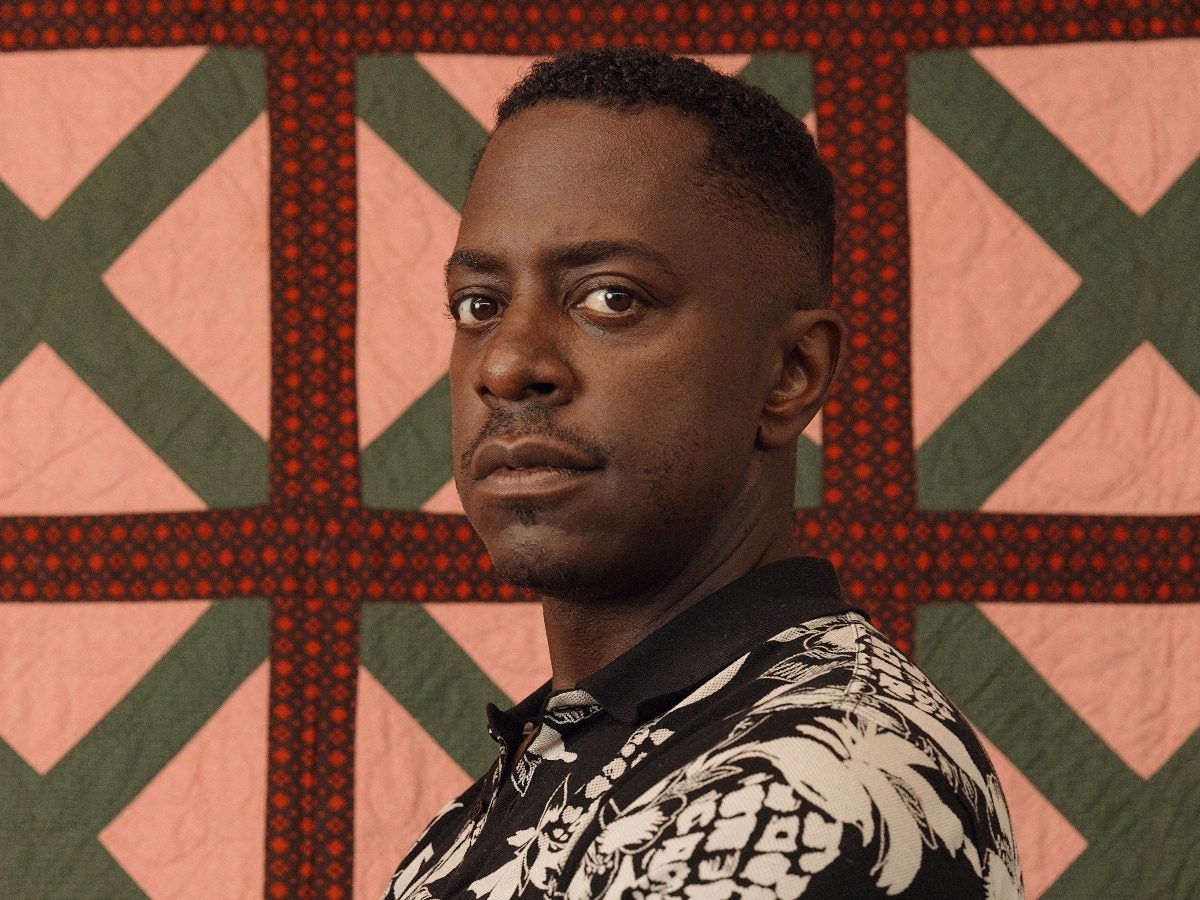
Sanford Biggers is telling a powerful story with Back To The Stars. Currently housed at Monique Meloche Gallery in Chicago, this new exhibition highlights the artist’s marble sculptures and quilt compositions, while creating a larger understanding of material culture.
Showcasing works from his ever-evolving Chimera and Codex series, Biggers’ show brings together compositions with familiar concepts while exploring new territory at the same time. By revisiting materials charged with references to his own career and art history, Sanford encourages his medium to take center stage while rejecting fixed narratives of quilt and marble traditions. Similar to his artistic practice, the materials that Sanford incorporates in Back To The Stars is more than meets the eye.
“I use mostly found, donated, traded quilts, preferably from pre-1900, but a whole gamut,” he tells ESSENCE. “But I also do collages and textile pattern collage works on paper from the quilts. So there’s a whole lot of other applications for the patchwork of the quilts and various fabrics.”
For this 2017 Rome Prize recipient’s new show, duality can also be described as one of its themes. Here, Biggers asks the viewer to examine the connection between the masculine and feminine, durable and delicate, eternal and ephemeral; while using his art testament to embrace the balance of life, regardless of its uncertainty. The combination of the artist’s Chimera sculptures, and the kaleidoscopic Codex series, serve as a revelation of how important it is to celebrate, as well as examine the people, places, and materials that precedes us all.
Additionally, Sanford has an exciting outdoor installation that can be seen at The Newark Museum of Art on October 20. Apollo (Diptych) features two 3-foot black and white marble sculptures mounted on bronze plinths. Both sculptures depict a unique interpretation of the Classical Greek god Apollo wearing a large mask derived from African sources.
As for Back To The Stars, Biggers hopes that viewers build from their own perspective when looking at the work. “When one sees this, they sort of have to create more of a story, more of a sense of trying to place where these things might have come from or what culture they may have come from,” he says.
“It makes them do a little bit more work, but at the same time, it’s forms, I think, and ideas and formats that people have seen at some points in their life, but maybe not combined in this way.” Biggers continues. “I think it was a way of just exploring and seeing how the forms themselves and the materials could express an idea more so than having an exact thing that I want each of you to get from it.”
ESSENCE: This is your fourth solo exhibition at Monique Meloche. Can you tell me what is so significant about this gallery that you continue to showcase your work here, and how did that relationship develop?
Sanford Biggers: Well, Monique and I go back to when I lived in Chicago during graduate school, and I think the first one was around close to 10 years ago now, and it was a window project and we had a couple of shows, and we just have a long-standing relationship. It’s a place where I like to try new things out, introduce new bodies of work.
So just even going back to your earlier work, I want to know from your perspective, why do you think that negative experiences or moments of trauma seem to produce the best and most resonant works of art?
I mean, I think they have their place, but I think there’s also a host of other emotions and feelings that create great work as well. I think there’s joy, I think there’s curiosity, generosity, experimentation, improvisation. I think all those things are there and I think they all feed each other.
As far as your work goes, when you’re purchasing or receiving these quilts, how do you know which ones you’re going to keep, and what are you seeing when you’re searching for fabric?
I’ve gone through different phases. I’ve had times where I just sort of use whatever I can get my hands on, and part of that was just because I couldn’t get much at a certain time. And the other thing is just trying to figure out and learn how to work within these very sort of complicated, ready-made pieces. Because each fabric works very differently than the next one, obviously. If you have hundreds of different fabrics on any given quilt and the older they are, they react differently to different agents and things you use. So a lot of that was experimentation.
I think I’ve gone through phases where I like a certain type of quilt or certain type of surface quality, stitching, depth of the batting, different qualities. Sometimes they feel sculptural, sometimes they feel like paper or just cloth with nothing behind it.
With you being a musician as well – when you’re creating, do you see any parallels between making music and constructing these works of art that you do?
Yeah, one of them is, I think at a certain point with both of them, you sort of have to try to trust the creative process. You can’t control it all. So I think that’s an important thing. And also, which is harder to describe, is sort of a feeling of when you’re in that creative space that it doesn’t really matter if it is a sculpture or a painting or playing with a band. It’s all sort of a creative energy that it’s a generative force.
In reading a previous conversation you had with the New York Times, a journalist wrote about a story saying that slaves communicated through quilts during the Underground Railroad, and that story may not be completely accurate. You responded by saying that “It’s more important that the story endures.” So in terms of your work, how much research do you do historically before you create a piece?
I do a lot of research historically, so much so that I know that one person is probably not going to get everything from one particular piece because there’s so many different references that I’m familiar with. But they are very idiosyncratic, you know what I mean? So different people get different things, they see different things, and that’s totally fine.
The pieces that I’m making are in a way historical, now the references are sort of there, but none of the mass or the figures or I think it goes into a different space. You know what I mean? So what you’re left behind with is sort of the aura of that history. And I find the more research I do, the further back you go with specific objects from antiquity, whether it be textiles or marble or bronze sculptures, there’s a point where they say, “We don’t know exactly who made it. We don’t know exactly what year, but we narrow it down to a small area.” So I mean, I think that’s the same point you get to with the quilts. So the fact that people say that it’s not true and it lives in vernacular history, on some level, is pretty similar to what you hear about other things through antiquity once you get to a certain point.













